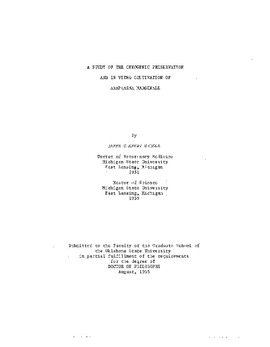| dc.contributor.author | Hruska, James Clement | |
| dc.date.accessioned | 2016-02-09T16:17:00Z | |
| dc.date.available | 2016-02-09T16:17:00Z | |
| dc.date.issued | 1965-08 | |
| dc.identifier.uri | https://hdl.handle.net/11244/27730 | |
| dc.description.abstract | Scope and Method of Study: This investigation is divided into two parts. The first part of the study was designed to demonstrate the feasibility of preserving the infectivity of Anaplasma marginale over long periods of time by means of deep freezing methods. For this purpose a comparison of freezing and thawing methods, with and without additives, was made. This information was then used to determine the infectivity of blood samples kept in a liquid nitrogen refrigerator, by injection into susceptible calves at 4-week intervals. The refrigerated blood samples were prepared with two different additives, one containing dimethyl-sulfoxide, the other a solution of sucrose and dextrose, and compared with samples to which no additive was included. Proof of the induced infection was demonstrated by a rising complement fixation titre, and the observation of marginal bodies in their blood. For the second part of this investigation, a series of experiments was designed in an attempt to grow Anaplasma marginale in vitro. Tissue cultures were employed as the medium of growth, and two different stains as well as a specific fluorescent antibody conjugate were used for microscopic observation of the cultures. Subsequent injection of calves, however, was the main criterion for proof of growth and infectivity. | |
| dc.description.abstract | Findings and Conclusions: Maintaining the infectivity of Anaplasma marginale for extended periods of time at the temperature of liquid nitrogen appears entirely practicable. Although observations were confined to a period of 196 days, the uniformly successful results obtained with the use of additives to the blood as contrasted with blood kept without additives, makes it possible to explain the variable results of others in previous years. The integrity of the red cell seems essential to maintaining the infectivity of Anaplasma marginale. With this in mind it seems safe to assume that preservation for many months or even years may be possible. While the results of the second part of this investigation are largely negative, the sustained infectivity of the organism kept at 37 degrees C. for four days on cell culture, (but not without such cell culture) offers some encouragement. The methods of this experiment, when coupled with the p02 concept of a latter experiment, might well merit further investigation. | |
| dc.format | application/pdf | |
| dc.language | en_US | |
| dc.rights | Copyright is held by the author who has granted the Oklahoma State University Library the non-exclusive right to share this material in its institutional repository. Contact Digital Library Services at lib-dls@okstate.edu or 405-744-9161 for the permission policy on the use, reproduction or distribution of this material. | |
| dc.title | Study of the cryogenic preservation and in vitro cultivation of anaplasma marginale | |
| osu.filename | Thesis-1965D-H873s.pdf | |
| osu.accesstype | Open Access | |
| dc.type.genre | Dissertation | |
| dc.type.material | Text | |
| thesis.degree.discipline | Veterinary Pathology | |
| thesis.degree.grantor | Oklahoma State University | |
